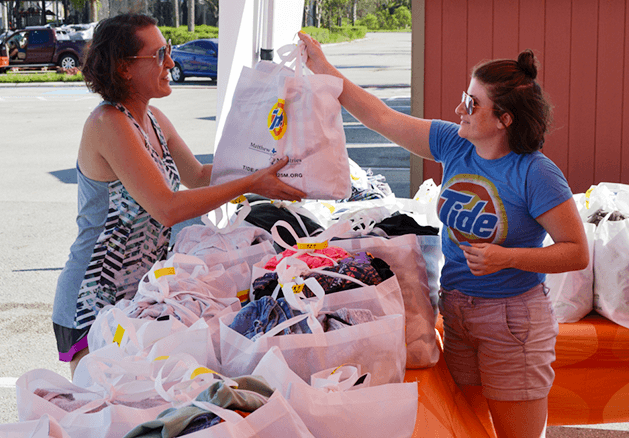Kindness in words creates confidence. Kindness in thinking creates profoundness. Kindness in giving creates love.
— Lao Tzu
Kindness is a powerful lever in creating brand trust.
Why do brands need to practice kindness? In short, kindness build trust. And trust builds love. In business, love means customers will prefer you. Brand preference makes customers less price sensitive and more loyal. A brand with a loyal base creates vocal fans, who then preach to friends and family, increasing market penetration.
Right now, it’s likely no one cares about your brand.
Despite what marketers might believe, most people couldn’t care less about your brand. Customers don’t hate it. They just can’t be bothered to think about your brand in their day-to-day lives.
In a recent study about brand indifference, BrandTrust examined how brand experiences can affect the “determination” of buyers. Over half of the brands included in the study had more “indifferents” and rejecters than fans.
These weren’t no-name brands either — the list included companies like Nike, Google, Apple, Samsung, and Coca-Cola. If over half these brands have more “indifferents” and rejectors than fans, what chance do the rest of us have?
How can your brand move from being ignored to being loved?
When brands use kindness as a genuine expression of caring for their employees and customers, it becomes part of their DNA. Here are four case studies about effective brand kindness in action:
1. Lend a helping hand, like Tide.

After Hurricane Katrina devastated the New Orleans area, millions of people couldn’t meet their basic of needs. Without electricity or running water, Hurricane victims were unable to clean their clothes for weeks. Tide saw an opportunity to help those in need created Loads of Hope, described by the company as:
A mobile laundromat developed to restore a sense of normalcy and dignity through the basic comfort of clean clothing for those in the midst of chaos.
Over the past 13 years, Loads of Hope has helped more than 48, 000 families across the United States affected by natural disasters like wildfires, tornadoes, and hurricanes. Not only have they brought a critical service to those in need, but the initiative has also created enormous goodwill with their customers.
2. Treat your employees with respect, like Patagonia
In “Let My People Go Surfing: 10 More Years of Business Unusual”, Patagonia’s CEO details how the brand’s purpose influences their HR policies.
The Patagonia brand exists to “to use business to inspire and implement solutions to the environmental crisis” and this mission influences how employees are treated at every level. Founder Yvon Chouinard believes work should be fun, and the company values employees who live well-rounded lives outside of work.

Patagonia’s famous flextime policy, called “Let My People Go Surfing”, means that employees can work when and where they want, so long as the work gets done. When the book was released twelve years ago, this was a breakthrough approach to employee management. Founder Chouinard believes that “there is a powerful connection between treating our things as disposable and treating the people who make these things as disposable.”
This approach has resulted in one of the best employee-attraction and retention ratios in the world. Their head of HR calls their turnover “freakishly low”. Your employees are your number one brand ambassador — treat them with kindness, dignity and respect, and they’ll create experiences customers love.
3. Put your money where your brand is, like USAA

When the U.S. government recently experienced the longest closure in its history, USAA — a bank that’s only available for active and retired military and their adult children — made no interest loans available until the government reopened.
Not only was this an act of kindness for their customers, but it also made financial sense for the brand. Without cash flowing in and out of USAA accounts, their business would come to a halt. By taking advantage of a real customer need, USAA not only kept themselves afloat but created thousands of grateful customers.
4. Go above and beyond, like LEGO
In 2012, a young boy with Aspergers named James Groccia wrote LEGO a letter. For two years, he’d been saving up for the Lego Emerald Night Train set. But when it came time to buy the set, LEGO had discontinued it.
James was upset, so he reached out to LEGO to let them know about his situation. And they delivered — they found a set and sent it to him for free. Without mentioning it in the press, LEGO simply did the right thing.
James’ mother recorded the moment her son received the train set and uploaded it to YouTube under the title “Why LEGO is the best company in the world”. At last count, the video had 1.8M views and 11k likes.
The lesson? Do the right thing when an opportunity presents itself. And don’t shout about it in the media — let customers do the talking. Otherwise, you won’t come off as kind, you’ll seem calculating.
When considering if an act of kindness is right for your customer experience, ask yourself:
- Is this act of kindness authentic or forced? Are you considering this project because everyone else is doing it or is it a natural step for your brand? Does it makes sense for your product or is it a bridge too far for customers?
- Is it intrusive or would the customer welcome it? Consider how you found the opportunity. Was it a data point or did a customer approach you? If a stranger approached you with this same offer, would you feel it’s creepy or kind?
- Is it creating joy at the right emotional moment? There’s a limit to how sensitive a moment you want to intrude on — should Walmart send you a condolence email when your mother dies? Probably not. But could every Walmart in an area devastated by tornadoes open its doors to become a shelter for 48 hours? More likely — and it would send a clear message that local stores are a real member of the community.
Beyond improving brand preference metrics and increasing market penetration, your business can reach into people’s lives at the right moment and make their world a slightly better place. If planned well, these acts of kindness can improve retention, satisfaction and your overall experience — a win-win for everyone.
Disclosure: Some of the links on my site and in this article are affiliate links. Meaning, at no additional cost to you, I will earn a commission if you click thru and make a purchase.
- Pre-suasion: A Revolutionary Way to Influence and Persuade, by Robert Cialdini (paid link)
- Thinking Fast and Slow, by Daniel Kahneman (paid link)
- 100 Things Every Designer Needs to Know About People, by Susan Weinschenk (paid link)
- Psychology for Designers, by Joe Leech (paid link)
Please note: this site contains Amazon affiliate links. As an Amazon Associate I earn from qualifying purchases. If you click the link to purchase one of the items, I may receive a small amount of monetary compensation from Amazon.
Found this article useful? You can check out my most popular articles below:

